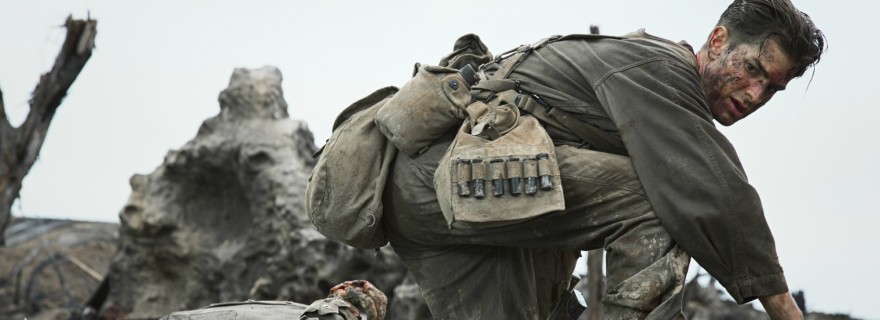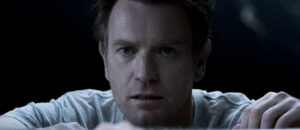'Hacksaw Ridge'
Movie Rating:
3
Oddly naïve and sweet in its Christian values, yet vicious to the point of exploitation in its violence, ‘Hacksaw Ridge’ is very much a conflicted movie. It’s also the latest film directed by Mel Gibson, a man who can be charitably described as conflicted himself. Here he’s crafted something that almost feels like a tale of atonement.
‘Hacksaw Ridge’ is a deliberately old-fashioned war melodrama with overtly Christian teachings and anti-violence messaging. It’s practically a feature-length letter begging for forgiveness from the filmmaker, proving that he can play nice and be a swell guy despite what you may have heard. That is, of course, until wartime. Then Gibson unleashes a flurry of gore-strewn shock tactics that practically fetishize violence. Don’t worry, though. It’s a love story too. Sheesh… Maybe the guy should have tried therapy.
The movie opens with two boys fighting and things getting out of hand. The brother who goes too far soon runs into the house to look at a mural of the Seven Deadly Sins and contemplate just how horrible violence can be. Yes, morality is laid on thick. That boy grows up to be Desmond (Andrew Garfield), a strapping young lad who would do anything to make his mother (Rachel Griffiths) proud and woo the heart of the beautiful nurse (Teresa Palmer) who makes him feel all fuzzy inside. So far, so cutie-pie.
Unfortunately, war is coming. Desmond’s poppa (Hugo Weaving) fought in the Big One and begged his sons not to ever join the Army. But that whole World War II thing happens and Desmond can’t resist. He needs to help because he’s such a good guy. So he signs up, gets yelled at by a drill sergeant (Vince Vaughn, yes really) and meets a gang of one-note soldier buddies begging to be killed. One catch, though: Desmond refuses to even hold a gun. He claims he’s a conscientious objector and wants to save lives as a medic, not take them. That obviously causes some head-butting with the likes of his confused captain (Sam Worthington).
That part takes up at least the first half of the film. Aside from the fact that there are so many famous contemporary faces on screen, you might be convinced that the movie is from the 1950s or even earlier. The tone is almost impossibly earnest. Everyone is just a little too pretty and a little too pure. True of the times? Perhaps, but Gibson almost seems to be going out of his way to craft traditional melodrama rather than reality. That’s fine, except this is based on the true story of Desmond T. Doss. It’s as if Gibson can’t see the purity of the man as real. Only the language of old Hollywood and fairy tales can capture his life. For the type of fluff the film represents, it’s all well made. But it’s hard not to stifle laughter at the way every actor behaves with either wide-eyed innocence or impossibly over-the-top swagger.
Then Desmond goes to war and it all changes. The big battle from the title was a slaughtering ground where hundreds of soldiers were mowed down over a cliff. Here, Gibson ditches all the old-timey optimism to embrace brutality and realism. This stuff makes the opening of ‘Saving Private Ryan’ look like a tranquil screensaver designed to promote meditations and/or napping. Every bit of the human body is exploded all over the screen in extreme close-up and slow motion. The battles rage on and only grows more disgustingly violent in every moment. It’s nasty, gag-inducing stuff – real, but in a way that clashes with the stylized innocence that came before. Then the real purpose of the movie arrives. You see, Desmond T. Doss spent an entire night dodging deadly enemies and dragging back injured men from Hacksaw Ridge. He singlehandedly saved dozens of lives and brought inspiration to all that bloodshed.
It’s a sweet story, just a weird delivery system. Things get even stranger when the inevitable American victory features even more savage violence presented as heroic even though it’s just as disgusting as everything that came before. It’s hard to figure out exactly what Mel Gibson’s intent was with this big sappy war movie. It can’t just be a Christian anti-violence parable given how much the filmmaker lovingly lingers on his on-screen nastiness. Something odd is going on here that’s kind of fascinating and frustrating in equal measure, both in terms of what the movie says about war and religion and in what the project accidentally reveals about its maker.
The movie is certainly well made. Gibson is a good director, after all, and the cast is too strong to fail even given the Hallmark sentiments that they’re required to spout. However, whether or not this is a good movie is really a matter of taste. It’s excessive in both quaint Americana and machine gun action in ways difficult to describe. Gibson has made a movie difficult to scrape from the psyche, but it’s also one of his least satisfying outings as a director.
This is the work of an artist at an uncomfortable crossroads in his career, trying to play it safe yet unable to contain his wildest tendencies. I guess that makes it fascinating, if not exactly brilliant. That’s kind of like Mel Gibson himself, in a strange way.




Darkmonk
So glad Mel is back.
What a great director.
Lord Bowler
I saw this last night. It was a great movie, sort of a mixture of The Patriot and Braveheart!
A truly amazing story of courage and valor.
David Staschke
Bruh… how can a movie be “vicious” and “nasty” if it’s just telling the truth? Do you realize war is violent, right? Was Mel supposed to sugar coat war to appease people with delicate sensibilities? Any depiction other than what was shown in this movie would be dishonest and disrespectful to veterans. You seem obsessed with psychoanalyzing Mel and worrying about his personal life instead reviewing the movie for what it is. Complaining about graphic violence in true war story is like complaining about nudity in a porno. Makes no sense. If I’m honest, I think it wasn’t violent enough.
Phil
Oh I agree that an honest war movie shouldn’t sugarcoat violence. It was the weird mix of that with the oddly pious and stylized storytelling early on (which didn’t feel remotely real) that sat awkwardly with me.
David Staschke
Ok, now that makes more sense to me. There definitely was a lot of corny cringe-worthy dialogue in the first hour. It reminded me of the first act of Pearl Harbor. But since this is a true story, I can’t really knock the duality.
Josh Zyber
The movie may be based on a true story, but it’s not a documentary. Gibson had to make decisions on how he wanted to dramatize the story.
David Staschke
I was referring to the truth of the main issue: a pacifist goes to war. That’s inherently dichotomous regardless of how its depicted. So I can’t complain about that. I just don’t think it’s productive to assume why Mel was drawn to this story or depicted it the way he did. I feel if the exact same movie was made by a different filmmaker we wouldn’t be talking about it this way. I couldn’t care less about an artist’s personal life, I care about being entertained. But that’s just me. I get why people have a hard time disassociating those two things.
NJScorpio
I saw this on Thanksgiving, and it was the perfect holiday movie for me.
I dug the old Hollywood style of war movie in the first half, and the jolt to realistic violence for the second half.
I feel that this is not a jarring change in tone, but a change in atmosphere for the soldiers. Prior, in the idealized boot camp, they repeatedly say that in order to save lives, a solder must be willing to pick up a gun and shoot at the enemy. When the violence hits, it can be seen how it is just body after body dropping, and no amount of shooting the enemy can offset the stream of dead bodies. This violence that everyone else thought very little of when criticizing the main character is now overwhelming them.